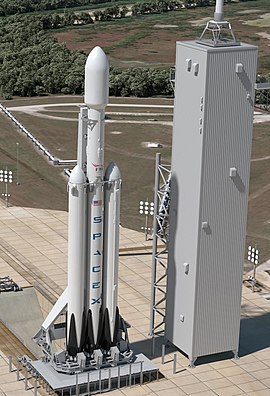Falcon Heavy

Artist's representation of Falcon Heavy Reusable on launchpad
|
|
| Function | Orbital super heavy-lift launch vehicle |
|---|---|
| Manufacturer | SpaceX |
| Country of origin | United States |
| Cost per launch | $90M for up to 8,000 kg to GTO |
| Size | |
| Height | 70 m (230 ft) |
| Diameter | 3.66 m (12.0 ft) |
| Width | 12.2 m (40 ft) |
| Mass | 1,420,788 kg (3,132,301 lb) |
| Stages | 2+ |
| Capacity | |
| Payload to LEO (28.5°) | 63,800 kg (140,700 lb) |
| Payload to GTO (27°) | 26,700 kg (58,900 lb) |
| Payload to Mars | 16,800 kg (37,000 lb) |
| Payload to Pluto | 3,500 kg (7,700 lb) |
| Associated rockets | |
| Family | Falcon 9 |
| Comparable | Delta IV Heavy, Angara A5V, Saturn C-3 |
| Launch history | |
| Status | In development |
| Launch sites | |
| Total launches | 0 |
| Successes | 0 |
| Failures | 0 |
| First flight | Summer 2017 (planned) |
| Boosters | |
| No. boosters | 2 |
| Engines | 9 Merlin 1D |
| Thrust |
Sea level: 7,607 kN (1,710,000 lbf) Vacuum: 8,227 kN (1,850,000 lbf) |
| Specific impulse |
Sea level: 282 seconds Vacuum: 311 seconds |
| Burn time | 162 seconds |
| Fuel | Subcooled LOX / Chilled RP-1 |
| First stage | |
| Engines | 27 Merlin 1D (two boosters plus single core) |
| Thrust | (boosters plus core) Sea level: 22,819 kN (5,130,000 lbf) Vacuum: 24,681 kN (5,549,000 lbf) |
| Specific impulse |
Sea level: 282 seconds Vacuum: 311 seconds |
| Burn time | 162 seconds |
| Fuel | Subcooled LOX / Chilled RP-1 |
| Second stage | |
| Engines | 1 Merlin 1D Vacuum |
| Thrust | 934 kN (210,000 lbf) |
| Specific impulse | 348 seconds |
| Burn time | 397 seconds |
| Fuel | LOX / RP-1 |
Falcon Heavy (FH), previously known as the Falcon 9 Heavy, is a reusable super heavy lift space launch vehicle being designed and manufactured by SpaceX. The Falcon Heavy is a variant of the Falcon 9 launch vehicle and will consist of a strengthened Falcon 9 rocket core, with two additional Falcon 9 first stages as strap-on boosters. This will increase the low Earth orbit (LEO) payload to 64 tonnes, compared to 22.8 tonnes for a Falcon 9 full thrust. Falcon Heavy was designed from the outset to carry humans into space, and would enable crewed missions to the Moon or Mars.
Following the Falcon 9 CRS-7 failure investigation in 2015, repeated rocket development delays, and given a very busy Falcon 9 launch manifest in 2016, the first Falcon Heavy is now tentatively scheduled for launch during the summer of 2017, contingent upon the repair of Cape Canaveral Air Force Station Space Launch Complex 40.
Elon Musk first mentioned Falcon Heavy in a September 2005 news update, referring to a customer request from 18 months prior. Various solutions using the planned Falcon 5 had been explored, but the only cost effective, reliable iteration was one that used a 9-engine first stage - the Falcon 9. Further exploration of the capabilities of the notional Falcon 9 vehicle led to a Falcon 9 Heavy concept: "two first stages as liquid strap on boosters, like Delta IV Heavy, allowed us to place about 25 tons into LEO – more than any launch vehicle in use today."
At this time the Falcon 1 had not seen its first flight yet, but SpaceX were intending to use a fleet composed of the 1, 5, 9 and Heavy variants, using the same Merlin engine across all vehicles to achieve cost savings and reliability through mass production. "I want to emphasize that although SpaceX development is now primarily on the Falcon 5/9, Falcon 1 is and will always remain a very important part of our business. I think that once the satellite market has time to adapt to its existence, Falcon 1 may very well see the highest launch rate per year of any rocket in the world."
...
Wikipedia
